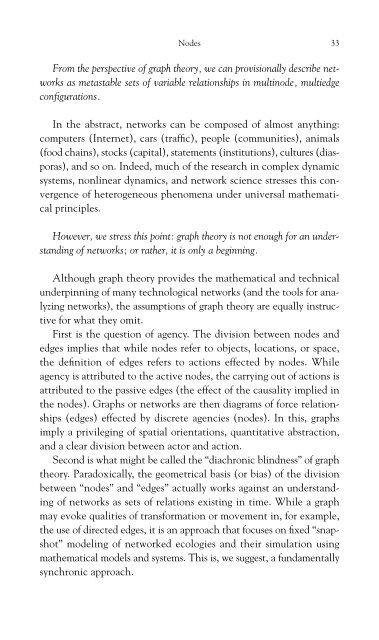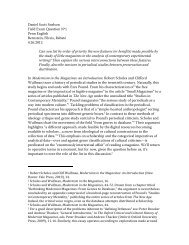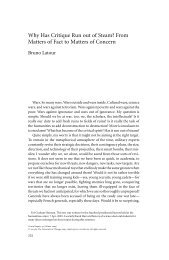The Exploit: A Theory of Networks - asounder
The Exploit: A Theory of Networks - asounder
The Exploit: A Theory of Networks - asounder
You also want an ePaper? Increase the reach of your titles
YUMPU automatically turns print PDFs into web optimized ePapers that Google loves.
Nodes 33<br />
From the perspective <strong>of</strong> graph theory, we can provisionally describe networks<br />
as metastable sets <strong>of</strong> variable relationships in multinode, multiedge<br />
configurations.<br />
In the abstract, networks can be composed <strong>of</strong> almost anything:<br />
computers (Internet), cars (traffic), people (communities), animals<br />
(food chains), stocks (capital), statements (institutions), cultures (diasporas),<br />
and so on. Indeed, much <strong>of</strong> the research in complex dynamic<br />
systems, nonlinear dynamics, and network science stresses this convergence<br />
<strong>of</strong> heterogeneous phenomena under universal mathematical<br />
principles.<br />
However, we stress this point: graph theory is not enough for an understanding<br />
<strong>of</strong> networks; or rather, it is only a beginning.<br />
Although graph theory provides the mathematical and technical<br />
underpinning <strong>of</strong> many technological networks (and the tools for ana -<br />
lyzing networks), the assumptions <strong>of</strong> graph theory are equally instructive<br />
for what they omit.<br />
First is the question <strong>of</strong> agency. <strong>The</strong> division between nodes and<br />
edges implies that while nodes refer to objects, locations, or space,<br />
the definition <strong>of</strong> edges refers to actions effected by nodes. While<br />
agency is attributed to the active nodes, the carrying out <strong>of</strong> actions is<br />
attributed to the passive edges (the effect <strong>of</strong> the causality implied in<br />
the nodes). Graphs or networks are then diagrams <strong>of</strong> force relationships<br />
(edges) effected by discrete agencies (nodes). In this, graphs<br />
imply a privileging <strong>of</strong> spatial orientations, quantitative abstraction,<br />
and a clear division between actor and action.<br />
Second is what might be called the “diachronic blindness” <strong>of</strong> graph<br />
theory. Paradoxically, the geometrical basis (or bias) <strong>of</strong> the division<br />
between “nodes” and “edges” actually works against an understanding<br />
<strong>of</strong> networks as sets <strong>of</strong> relations existing in time. While a graph<br />
may evoke qualities <strong>of</strong> transformation or movement in, for example,<br />
the use <strong>of</strong> directed edges, it is an approach that focuses on fixed “snapshot”<br />
modeling <strong>of</strong> networked ecologies and their simulation using<br />
mathematical models and systems. This is, we suggest, a fundamentally<br />
synchronic approach.









